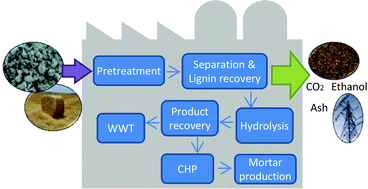Co-production of biorefinery products from kraft paper sludge and agricultural residues: opportunities and challenges
Abstract
As a main stream of waste from the paper and pulp industry, paper sludge is regarded as a threat to environmental safety as most of it is disposed via landfill or incineration, which can cause severe soil, water or air pollution. However, alkaline paper sludge has the potential to be a catalyst in biomass pretreatment, and also contains a large amount of fiber that can be used as a feedstock for ethanol production. The dissolved lignin in alkaline pretreatment can be recovered as a good quality co-product such as lignin pellets. The ash in paper sludge can also be recovered to replace sand as a raw material in mortar production. However, the use of paper sludge for commercialized ethanol production is currently a challenge due to its low solid content and high pH. This paper therefore proposes a novel conceptual design for combining paper sludge and agricultural residues (e.g. rice straw in this study) to produce ethanol and other co-products. The net present value is used to assess the economic potential of two proposed process designs: (1) a current technology of turning C5 sugars into biogas; and (2) a prospective technology of co-fermenting both C5 and C6 sugars into ethanol. It is found that both approaches could be economically feasible, but at different scales of production. A sensitivity analysis is also conducted to investigate the effects of plant size, feedstock stream composition (the ratio between rice straw and paper sludge) and subsidies on the economic performance of the proposed projects.


 Please wait while we load your content...
Please wait while we load your content...